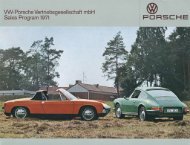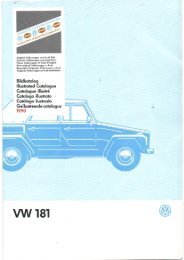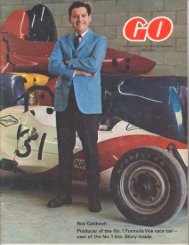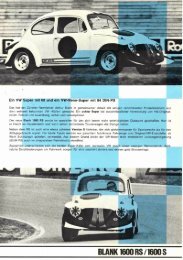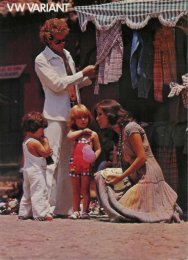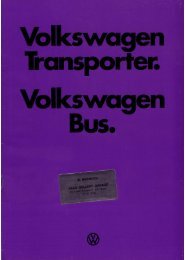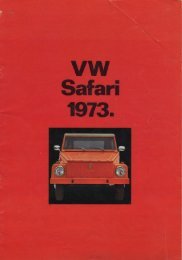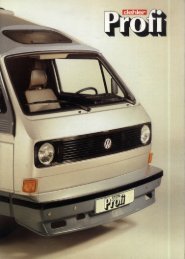Create successful ePaper yourself
Turn your PDF publications into a flip-book with our unique Google optimized e-Paper software.
Above: Rosewood dash sets olf well-finished interior. Steering is light and precise, with<br />
just 2.7 turns lock-to-lock and only 40% of the car's weight on the front wheels. Small<br />
diameter wheel increases thigh room. Below: After arrival at factory, each VW chassis is<br />
completely disassembled preparatory to shortening operation. Output is now at 20 cars a month.<br />
56 MOTOR TREND/ MAY 1971<br />
-<br />
---<br />
(<br />
front-wheel braking is stronger than it<br />
used to be, and much more fade-resistant,<br />
since discs have been added. The<br />
brakes are powerful and well-balanced.<br />
Designed to run on 76 octane gasoline,<br />
the P uma's home-market engine<br />
offers only moderate performance. Built<br />
in Brazil in 1600 cc size, it's not as<br />
sharp and responsive in feel as the 1600<br />
that Puma used to make out of the VW<br />
1300 engine. Through the gears its typically<br />
VW rumble is louder inside the<br />
car than it should be, yet at cruising<br />
speed (80 to 90 mph) in fourth it quiets<br />
down nicely, enough so it's possible to<br />
appreciate the Puma's impressively low<br />
wind noise. T op speed is just over 100.<br />
Like most production gearboxes annexed<br />
for sports car use, the one in the<br />
P uma feels short-legged in first and second<br />
gears. T hird is very useful, though,<br />
winding out to almost 75 mph. The shift<br />
lever is quick and positive in use but<br />
placed farther forward than it should<br />
be. That lever, the central handbrake<br />
and heater control, and the typical<br />
pedals are the only clues inside the<br />
Puma that it's built on the humble<br />
Bug platform.<br />
T he uprated export engine is used in<br />
the cars destined for the first P uma<br />
target market abroad: Switzerland. It<br />
was originally to have been the United<br />
States. To that end GTE number one<br />
made its bow at the New York Show in<br />
April, 1970. Puma had begun its own<br />
development work on intake-air beating<br />
and other measures to reduce emissions,<br />
in spite of the tremendous difficulties<br />
involved in even getting the equipment<br />
needed to measure emissions, in Brazil.<br />
This work was only partly completed<br />
when sudden demand from the Swiss<br />
market, with its less demanding regulations,<br />
caused a shift in export policy.<br />
Pumas may be coming to the U.S., but<br />
not for a while yet.<br />
Many subtle and practical body<br />
changes were made during the switch<br />
to the GTE (E for Export) Puma in<br />
mid-1970. The lid over the front fuel<br />
tank and small luggage compartment is<br />
hinged at the front instead of the rear.<br />
Curved instead of squared, the lower<br />
corners of the windshield look better<br />
and leak less. A compound-curved rear<br />
window matches the body lines better<br />
than the old flat glass, and with new<br />
fiberglass molds, all the body lines were<br />
sharpened and refined.<br />
New magnesium wheels were commissioned<br />
to match the changed bolt patterns<br />
of the new VW chassis, and the<br />
wheel houses were deepened to give<br />
more jounce travel and clearance. In the<br />
front cowl and below the rear window<br />
are new inlets and outlets for a flowthrough<br />
ventilation system. The former<br />
ventilation inlets below the front bumper<br />
are now used for front brake cooling.<br />
Larger taillight lenses with built-in<br />
continued on page 58




